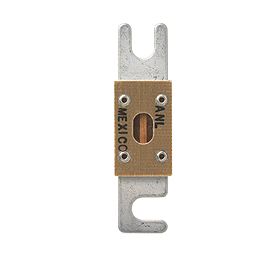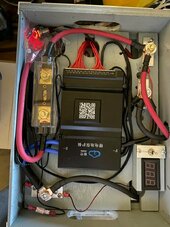ANLs
ANL is only rated up to 32V though.
ANLs
Not if you get the right one.ANL is only rated up to 32V though.

Accidentally blew a class T fuse. Replaced it with ANL, accidentally blew it also, nothing spectacular. So, I am now using ANLs.
Picture shown is after the accident. Battery pack is 16S 105AH LiFePo4. ANL is 150A rated. AWG #6 cables used. Ends of red and black 3 ft cables (right side of picture) accidentally touched together.But did you blow it with a worst-case short?
Overload doesn't count. Short through longer higher resistance wire doesn't count.
To test this correctly, you want short fat wires and a fat switch or contactor to create a bonded fault.
And you want to test with margin above voltage and current you plan to "rate" it for.


Yeah, I HATE any crossover of primary cables on any of my builds.Picture shown is after the accident. Battery pack is 16S 105AH LiFePo4. ANL is 150A rated. AWG #6 cables used. Ends of red and black 3 ft cables (right side of picture) accidentally touched together.
View attachment 197797
Depends upon how many batteries you have. If you have 4 batteries, that is the potential for 1000 amps (4x250) before the Battery Class T blows. So protecting the Inverter line with a Class T can protect against a short after the busbar.I ordered Victron switches, DC breakers, and 250a T-class fuses for every battery for battery to bus bar.
As well as 300a T class from inverter to bus bar.
No clue if that’s “excess” or not, but figured the peace of mind was cheaper
For $59.99, I received 175A Class T fuse and the holder and I had free shipping.Affordable alternative to class T

Eaton AMX and AMH Fuses alternative to Class T
I think I found a really interesting 10-15$ fuse alternative to Class T fuses. Eaton Bussmann AMH specs: -current ratings 350A, 400A or 500A -ultra-high interrupting ratings, up to 20,000 A. -voltage ratings, up to 125 Vdc Eaton Bussmann AMX specs: -current ratings 80A to 350A -ultra-high...diysolarforum.com
I'm not a fan of stacking on terminals either. I'm anal about busbars.Yeah, I HATE any crossover of primary cables on any of my builds.
I am kinda anal about it.
It's not my system, but I don't like how close those uncovered/unshielded busbar/terminals are.Picture shown is after the accident. Battery pack is 16S 105AH LiFePo4. ANL is 150A rated. AWG #6 cables used. Ends of red and black 3 ft cables (right side of picture) accidentally touched together.
Great vid ..…and techniques ….I like a man that does things the right way with the right stuff… J.I'm not a fan of stacking on terminals either. I'm anal about busbars.
When I did my junction box for charge controllers, I made an insulated standoff under one busbar so the cables would not lay over the other busbar or cables. Shown here in this part of a video of mine.
Agreed, but I was trying to fit everything in a space not intended for the EVE F105 cell/battery pack. By the way, not shown, the cabinet has a non-metal cover on top.It's not my system, but I don't like how close those uncovered/unshielded busbar/terminals are.
That seems like an(other) accident waiting to happen.

If you cannot reroute the cable, at least rotate the lug over so cable isn’t resting on the negative stud.Agreed, but I was trying to fit everything in a space not intended for the EVE F105 cell/battery pack. By the way, not shown, the cabinet has a non-metal cover on top.
View attachment 197959
Right. But a breaker on the battery? Should, right?In the recent Shunt Fire thread, a breaker at the AIO does not do any good
YupRight. But a breaker on the battery? Should, right?


